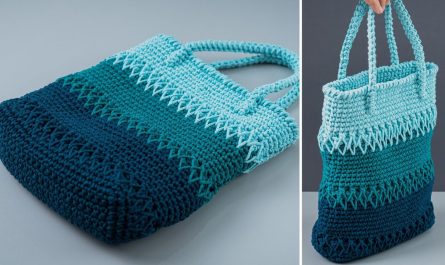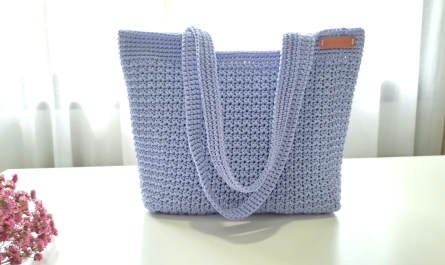Let’s create a chic and practical crochet square handbag perfect for beginners! This project is designed to be straightforward, primarily using basic stitches and simple construction techniques. You’ll learn how to create flat square panels and assemble them into a stylish, functional bag, making it a satisfying and achievable first handbag project.
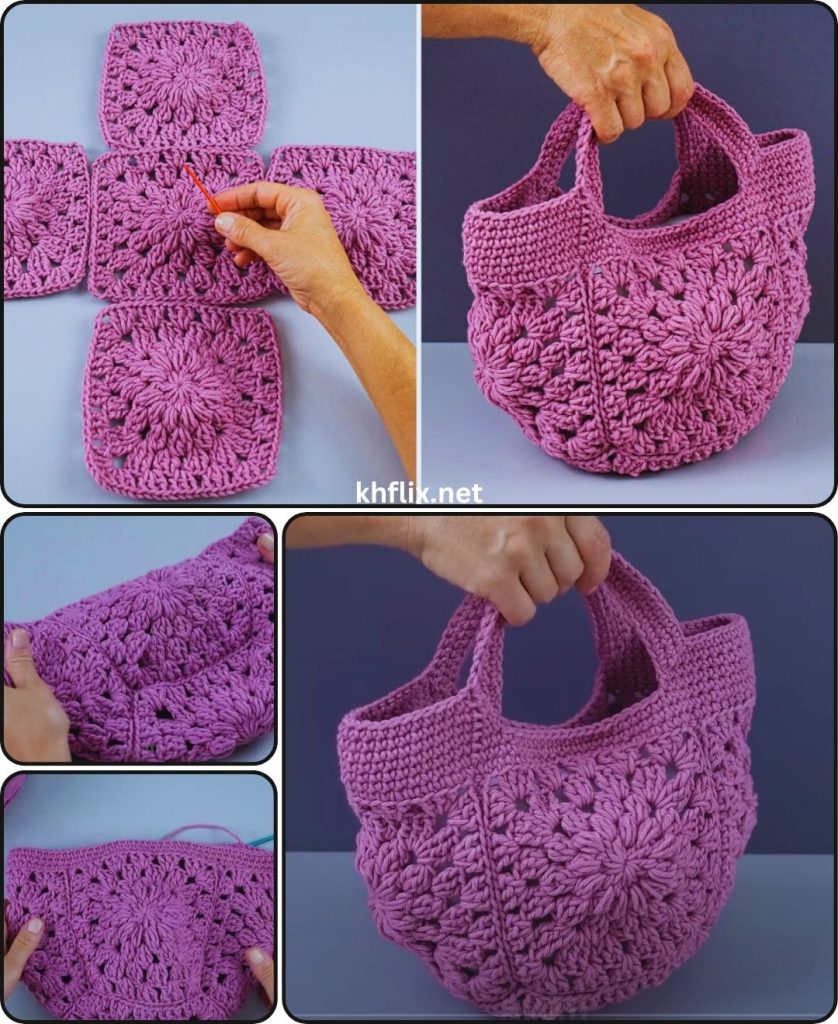
How to Crochet a Square Handbag for Beginners
This detailed guide will walk you through making a classic square handbag. We’ll focus on creating sturdy panels and a comfortable strap, ensuring a durable and attractive finished piece.
Skill Level: Beginner
This project is ideal if you’re comfortable with (or ready to learn!):
- Chain (ch): The basic foundation stitch.
- Single Crochet (sc): A dense stitch, great for sturdy bag fabric.
- Slip Stitch (sl st): For neatening and joining.
- Working in rows: Crocheting back and forth.
- Fastening off: Securing your work.
- Weaving in ends: The essential finishing touch.
- Basic seaming: Joining edges with a yarn needle.
Finished Handbag Dimensions (Approximate):
Using worsted weight yarn and the suggested hook, your finished handbag will typically measure about 10-12 inches (25-30 cm) wide and 10-12 inches (25-30 cm) tall (excluding the strap). This is a versatile size for everyday essentials.
Materials You’ll Need:
Gathering your materials beforehand makes for a smoother crocheting experience.
- Yarn: Approximately 350-450 yards (320-410 meters) of Worsted Weight (Medium #4) Cotton or Cotton Blend Yarn.
- Why Cotton? Cotton yarn is highly recommended for bags because it’s durable, has minimal stretch, and provides excellent stitch definition, which helps the bag hold its shape. Acrylic yarn can work, but may stretch more over time.
- Color Choice: Choose a solid color you love for a classic look, or experiment with a variegated yarn for an easy pop of color.
- Crochet Hook: Size H/5.0mm. This hook size works well with worsted weight yarn to create a dense, sturdy fabric for your bag.
- Yarn Needle (Tapestry Needle): Essential for seamlessly weaving in all your loose yarn tails and for seaming the bag panels together. It has a blunt tip and a large eye, making it easy to thread yarn through.
- Scissors: Any pair of sharp scissors will do for cutting your yarn.
- Stitch Marker (Optional): Useful for marking the end of rows, especially when you’re starting out.
Understanding the Handbag Construction: Simple Squares
This handbag is built in a straightforward manner using flat square panels:
- Three Identical Panels: You’ll crochet three identical flat square panels that will form the front, back, and bottom of your bag.
- Two Side Panels: You’ll crochet two smaller rectangular panels for the sides of the bag.
- Seaming: All five panels will be sewn together to form the bag’s body.
- Strap: A sturdy crocheted strap will be added for carrying.
Let’s Crochet Your Square Handbag!
Follow these steps carefully. The key is to maintain consistent tension for a neat-looking bag and straight edges.
Part 1: Crocheting the Front, Back, and Bottom Panels (Make 3)
These are the main square pieces of your bag. We’ll use single crochet (sc) for a dense, durable fabric.
- Starting Chain:
- Begin by making a slip knot with your yarn and placing it onto your H/5.0mm crochet hook.
- Chain (ch) 36. (This will determine the side length of your square. Adjust for a larger or smaller bag, but remember your stitch count will be one less than your starting chain.)
- Row 1:
- Work 1 single crochet (sc) into the 2nd chain from your hook.
- Continue to work 1 sc into each remaining chain across the entire row. You should have a total of 35 single crochet stitches.
- Chain 1 (ch 1) (this turning chain does NOT count as a stitch; it just gives height for the next row).
- Turn your work.
- Rows 2-35 (or until square shape):
- Work 1 sc into the first single crochet stitch of the previous row (this will be the very first stitch of the row you just turned).
- Work 1 sc into each remaining sc stitch across the row. You should still have 35 sc stitches in each row.
- Chain 1, turn your work at the end of each row.
- Repeat this pattern for a total of 35 rows. This will create a square panel that’s roughly 10-12 inches wide and 10-12 inches tall.
- Tip: To ensure your panel is square, lay it flat and measure both sides. The width (from your starting chain) and the height (number of rows) should be approximately equal.
- Fasten Off:
- After completing your last row, cut your yarn, leaving a tail about 6-8 inches (15-20 cm) long.
- Yarn over with your hook, pull the cut tail completely through the loop left on your hook, and gently tug to secure the knot.
- Repeat these steps to make two more identical square panels. You should have three squares in total.
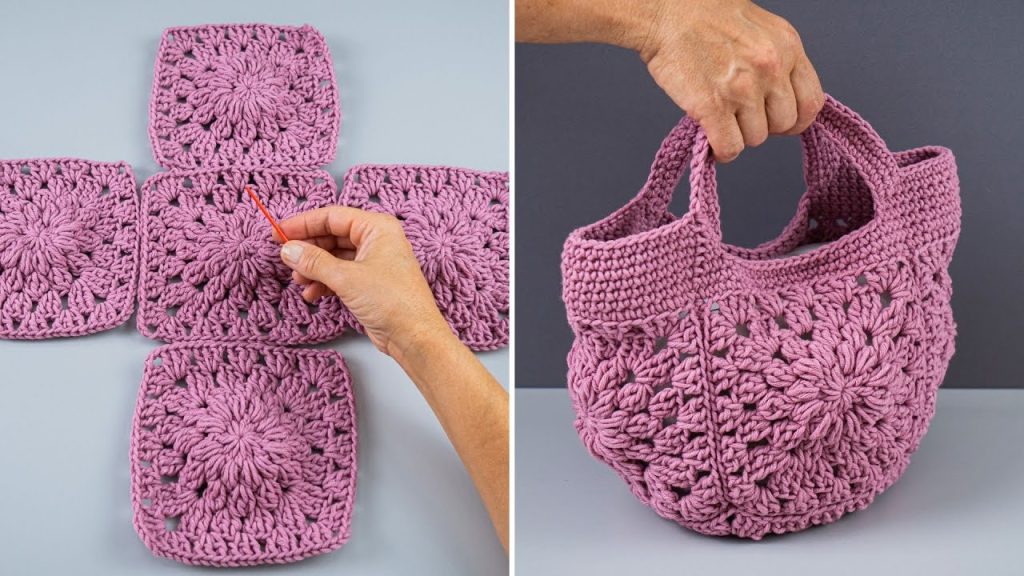
Part 2: Crocheting the Side Panels (Make 2)
These smaller rectangular panels will form the sides of your bag, giving it depth.
- Starting Chain:
- Make a slip knot with your yarn.
- Chain (ch) 36. (This will be the height of your bag, matching the side of your square panels.)
- Row 1:
- Work 1 sc into the 2nd chain from your hook.
- Work 1 sc into each remaining chain across the entire row. You should have a total of 35 single crochet stitches.
- Chain 1, turn your work.
- Rows 2-5 (or desired depth):
- Work 1 sc into the first single crochet stitch.
- Work 1 sc into each remaining sc stitch across the row. You should still have 35 sc stitches in each row.
- Chain 1, turn your work at the end of each row.
- Repeat this pattern for a total of 5 rows. This will create a rectangle that’s roughly 10-12 inches tall and 2-3 inches wide (this is the depth of your bag).
- Tip: For a deeper bag, add more rows here. For a thinner bag, use fewer rows.
- Fasten Off:
- After completing your last row, cut your yarn, leaving a very long tail (at least 30-40 inches / 75-100 cm) for seaming.
- Repeat these steps to make a second identical side panel. You should have two rectangles in total.
Part 3: Assembling the Bag Body
This is where your flat pieces come together to form the bag!
- Layout:
- Lay out your three square panels in a row. The middle square will be the bottom of your bag, and the outer two will be the front and back.
- Take one of your side panels. You will attach it to the side of the bottom square and then up the side of the front and back squares.
- Seaming the First Side:
- Thread the very long yarn tail from one of your side panels onto your yarn needle.
- Align one long edge of this side panel with the edge of the first square (front panel).
- Begin to stitch the side panel to the main panel. Use a simple whip stitch or a mattress stitch. Go through both loops of the stitches on both pieces for a strong seam. Stitch all the way down.
- Now, pivot and continue stitching the same side panel to the edge of the middle square (bottom panel).
- Then, pivot again and continue stitching the same side panel to the edge of the third square (back panel).
- You should now have one long side of the side panel stitched to the front, bottom, and back panels. Secure the end of your seam (if you run out of yarn, simply join a new long piece and continue) and weave in any remaining tail neatly.
- Seaming the Second Side:
- Take your second side panel.
- Repeat the process from Step 2, attaching it to the remaining un-seamed edges of the front, bottom, and back panels.
- Ensure your seams are neat and tight. When you reach the end, secure the yarn and weave in the tail.
- Tip: Take your time with seaming. Neat seams make a huge difference in the finished look of your bag. You might find it helpful to use stitch markers to temporarily hold the panels in place as you sew.
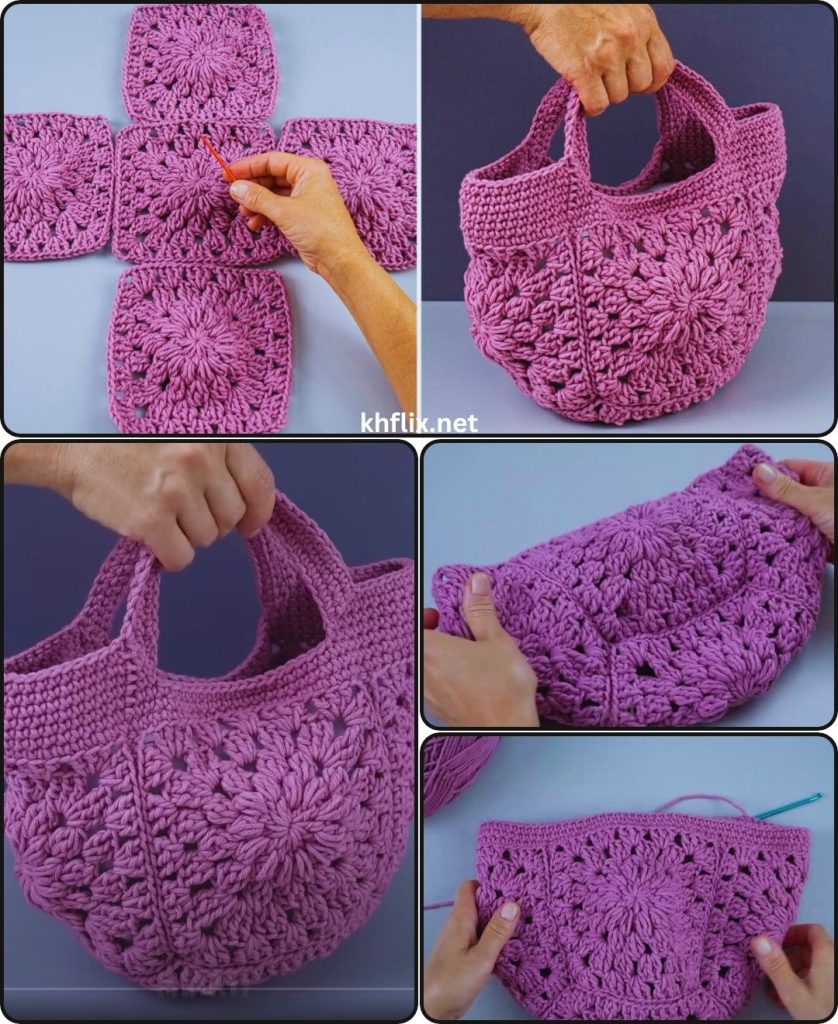
Part 4: Crocheting and Attaching the Strap
A comfortable and sturdy strap is essential for your handbag.
- Crocheting the Strap:
- Make a slip knot with your yarn.
- Chain (ch) 61. (This will create a strap of about 18-20 inches / 45-51 cm, suitable for carrying in your hand or over your shoulder. Adjust for desired length.)
- Row 1: Work 1 sc into the 2nd ch from your hook. Work 1 sc into each remaining ch across. [Total: 60 sc]
- Chain 1, turn.
- Rows 2-4: Work 1 sc into each sc across the row. [Total: 60 sc]
- Chain 1, turn. (You can make more rows if you want a wider, thicker strap.)
- Fasten off, leaving a very long tail (at least 10-15 inches / 25-38 cm) at each end of the strap for sewing.
- Attaching the Strap to the Bag:
- Lay your bag flat and find the top opening.
- Position the ends of your crocheted strap on the inside of the bag’s top opening, centered above where the side panels attach (about 1-2 inches / 2.5-5 cm in from the side seams).
- Thread one of the long tails from the strap onto your yarn needle.
- Stitch firmly back and forth, through the strap end and into the top edge of the bag, making sure to go through multiple stitches for a very strong attachment. Work your needle in a way that the stitches are discreet.
- Repeat for the other end of the strap, ensuring it’s not twisted.
- Weave in all remaining strap tails very securely into the top edge of the bag.
Part 5: Final Finishing Touches
- Weave in ALL Remaining Ends:
- This is crucial for a clean, neat, and durable bag. You’ll have tails from your panel starts, seam joins, and strap attachments.
- Use your yarn needle to meticulously weave in every single loose yarn tail.
- How to Weave Neatly: Thread the yarn tail onto your yarn needle. Weave the tail into the stitches of the same color. Go in one direction for at least 1.5-2 inches (4-5 cm). To truly secure it, subtly change direction (e.g., weave along a row, then turn and weave back through some of the same stitches diagonally or perpendicularly) to “lock” the tail in place and prevent it from unraveling. Trim any excess yarn close to the fabric, being careful not to cut any of your actual stitches.
- Blocking (Optional but Highly Recommended):
- Blocking can significantly improve the shape, even out any tension inconsistencies, and give your bag a more polished, professional look.
- Method (Wet Blocking – Ideal for Cotton):
- Gently mist your entire bag evenly with cool water using a spray bottle until it’s damp but not soaking wet.
- Carefully stuff your bag with clean towels or crumpled paper to help it hold its shape and define the square corners while drying.
- Smooth out any wrinkles and gently shape the bag to your desired dimensions.
- Allow the bag to air dry completely and thoroughly in a well-ventilated area. This can take several hours to a full day, depending on humidity and ventilation. Ensure it’s bone dry before handling or using it further.
- Add a Fabric Lining (Optional but Highly Recommended):
- A fabric lining provides a smooth interior, hides all your yarn tails, prevents small items from slipping through stitches, and adds significant durability and structure to your bag.
- Measure the inside dimensions of your finished bag precisely. Cut fabric pieces to match your crocheted panels, adding a seam allowance (e.g., 0.5 inches / 1.25 cm) to all edges.
- Sew the fabric pieces together to create an inner lining bag.
- Insert the fabric lining into your crocheted bag.
- Fold over the top raw edge of the fabric lining (using your seam allowance) and hand-stitch it neatly to the inside top border of your crocheted bag using a needle and matching strong thread.
- Add a Closure (Optional):
- For added security, you can add a simple magnetic snap, a button and loop, or a zipper to the top opening of your bag. If using a magnetic snap, sew it to the inside of the crocheted fabric or the fabric lining if you added one.
Congratulations! You’ve successfully crocheted a stylish and functional square handbag! This handmade accessory is perfect for carrying your daily essentials and showcases your growing crochet skills. Enjoy your new creation!



